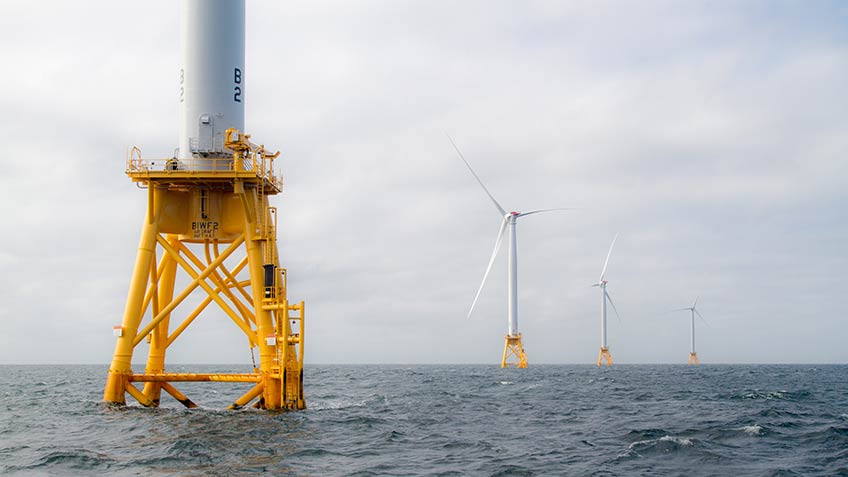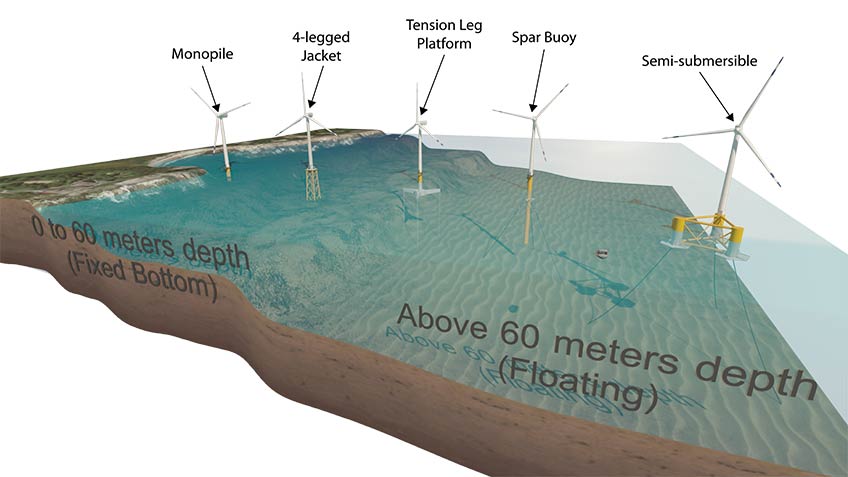Scientific Collaboration Buoys Future of Offshore Wind
Largely Untapped Resource Could Double U.S. Electricity Supply
Throughout history, adventurers have taken to the seas, propelled by the wind and a passion for new discoveries. Today, researchers at the Department of Energy’s (DOE’s) National Renewable Energy Laboratory (NREL) are charting a similar course of intrepid exploration, in search of new energy solutions where the water meets the sky.
Offshore wind, with its potential for domestic electricity-generating capacity of more than 2,000 gigawatts (GW), could supply enough electricity to meet the needs of the entire United States two times over. A portion of this capacity is situated in areas closer to shore that can accommodate traditional fixed-bottom foundations, but the greatest wind resource is in deeper waters that can only be tapped with floating platforms. To ensure more power can be harnessed and fed to U.S. homes and businesses, technical, logistical, financial, and environmental challenges need to be addressed—especially to make newer floating turbine technology successful.
NREL researchers are leading the way in clearing those hurdles to provide reliable, affordable, and accessible offshore wind energy. The laboratory’s researchers are making advances in characterizing wind resources, optimizing systems, and enhancing market viability for the benefit of consumers, industry, and the environment.
“Offshore, it’s possible for us to generate wind energy near densely populated coastal regions, where there is abundant space for large wind plants and minimal interference with existing land use,” said NREL Offshore Wind Platform Lead Walt Musial. “Current trends indicate that we can make these systems reliable and cost-competitive, positioning offshore wind to expand and diversify the U.S. portfolio of renewable energy resources.”
In 2019, states doubled their commitments to offshore wind, announcing plans to add another 16 GW. More than 25 GW are already in development off the East Coast and in the Great Lakes, and interest in the West Coast is growing among offshore investors. Several large-scale fixed-bottom offshore wind projects are expected to be in operation by 2025.
NREL contributions helped turn the tide on those breakthrough projects, and the laboratory continues to steer research needed for offshore wind to realize its full, long-term potential—including the fundamental technology that will make floating wind feasible. Sites at depths greater than 60 meters (m) represent 58% of the nation’s viable resource area but will require floating technology to establish offshore wind in many more regions, in greater quantities, and with fewer siting issues.
Leveraging their broad-based expertise and world-class facilities, NREL researchers are pulling together with partners from industry, the research community, and other government agencies to map a swift, direct, and enduring route to commercially viable offshore development.

Steering Toward Favorable Economic and Technologic Currents
NREL has helped steer R&D into favorable economic and technologic currents, building on earlier European advances and carrying U.S. offshore wind closer to a welcoming harbor. In just a couple years, offshore prices have dropped from $200 per megawatt-hour (MWh) to roughly $75 per MWh, while turbine rotors have grown in size to 170 m with an average capacity of up to 9.5 MW.
“It’s great to see these new technologies and approaches delivering more energy for a lower cost,” said NREL Senior Research Engineer Garrett Barter. “But we still have a long way to go before offshore wind reaches its full potential and is truly a cost-competitive source of electricity, complementing the supply generated from traditional and other renewable resources.”
Larger turbines and installations, increased competition, and maturing supply chains are all driving down offshore costs, but further cost reductions and technological advancements are still needed for offshore wind to compete unsubsidized with other forms of generation. Only with continued innovation and new strategies can offshore wind overcome challenges ranging from turbine system size and complexity to utility-scale grid integration, environmental impacts, and the effects of wind wake blockage, meteorological, and ocean conditions.
NREL and its partners are addressing these barriers, examining ways to make both fixed-platform and floating options cost-competitive, while improving performance, operations, and maintenance in difficult marine conditions.
Researchers are focusing on:
- Resource characterization
- Plant and turbine optimization
- Techno-economic and market analysis
- Environmental impact evaluation
- Energy systems integration
- Advanced design tool development.
NREL drives science and innovation in each of these areas, understanding that a wide range of breakthroughs are needed to most effectively advance offshore wind toward a market-viable tomorrow.
Future features in this series will spotlight each of these research undertakings and some of the more than 20 organizations the laboratory is currently working with on offshore wind projects.
Partnerships To Circumnavigate the Globe
NREL’s collaboration with academic and industrial partners around the world, as well as with government agencies, makes it possible to navigate the difficult route from early-stage research to commercialization, delivering sustained results that factor in operational and marketplace realities.
The International Energy Agency Wind Technology Collaboration Programme (IEA Wind) has repeatedly tapped NREL to lead and contribute to projects in cooperation with its 21 member countries. Recent NREL projects for IEA Wind have included developing a 15-MW reference wind turbine and reviewing standards for offshore wind installations.
The laboratory plays a central role in convening U.S. partners and other national laboratories in pursuit of wind energy innovation, thanks in large part to sponsorship from the DOE Wind Energy Technologies Office (WETO). In addition to managing the National Wind Technology Center at its Flatirons Campus, NREL provides leadership and R&D support for the National Offshore Wind R&D Consortium established by WETO and the New York State Energy Research and Development Authority.
“The consortium is led directly by offshore wind developers and states, who are the end users of the funded research. Through their insights, we’re able to work to break down technical barriers to offshore wind development in the United States,” said Musial, who is a lead technical advisor for the consortium.
Another DOE office, Advanced Research Projects Agency-Energy (ARPA-E), has funded cooperative Aerodynamic Turbines Lighter and Afloat with Nautical Technologies and Integrated Servo-control (ATLANTIS) research to develop new floating offshore wind turbines by tightly integrating control systems and design. NREL leads three projects funded under this program and contributes to others directed by university and industry partners.
The laboratory also collaborates with other U.S. government agencies, including the Bureau of Ocean Energy Management, the National Oceanic and Atmospheric Administration, and the Bureau of Safety and Environmental Enforcement. Working with these agencies and other partners, NREL is contributing to offshore wind feasibility studies, resource modeling and validation, standards development, and techno-economic analyses.
NREL’s direct partnerships with corporate partners and trade associations such as the Business Network for Offshore Wind and the American Wind Energy Association have helped establish industry standards and define requirements for commercial adoption of offshore wind.

Innovation Anchored by Real-World Considerations
Larger turbines and systems and lower capital and component costs, paired with steady technological advances, forecast a strong future for offshore wind. By 2035, the offshore wind industry is anticipated to generate nearly 30 GW of cost-competitive power and nearly $100 billion in capital expenditure for businesses in the U.S. supply chain, with levelized cost of energy as low as $50/MWh to $60/MWh.
Getting there, however, will require innovation anchored by real-world considerations. Barter sums up the challenges: “How do you harness wind power while buffeted by waves and ocean storms? How do you feed that energy to the grid and reliably get it to keep the lights on? And how do you do it all in a way that keeps costs down and wildlife safe?”
NREL and its partners are providing the R&D needed to keep offshore wind moving forward on the crest of this rising new energy tide.
Learn more about NREL offshore, land-based, and distributed wind research, along with partnership opportunities.
NREL Offshore Wind R&D
Other articles in this series spotlight the following NREL offshore wind research undertakings:
Resource Characterization
Extremes in ocean currents, depths, temperatures, and weather patterns put unusual demands on offshore wind installations. Wind resource mapping, remote sensor measurement, and forecasting can help make generation, resource, and load estimates more accurate, improve grid operational strategies, and strengthen systems’ abilities to withstand hurricanes and other natural phenomena.
Read more about how NREL resource characterization efforts guide offshore wind system decisions.
Plant and Turbine Optimization
Ever-larger turbine systems and associated infrastructure require a scaling-up of technology, logistics, and operations to support high levels of renewable penetration. At the same time, the offshore environment presents increased risks of energy production losses due to wakes. Identifying better properties and designs for materials, components, systems, controls, and surrounding dynamics can help deliver immense fixed-bottom and floating structures capable of generating energy at utility-scale.
Read more about how NREL helps maximize wind power plant and turbine output.
Techno-Economic and Market Analysis
Technology designs, site characteristics, supply chain requirements, and regulatory environments impact the cost and potential economic benefits of offshore wind. Understanding the direct and indirect economic impacts of offshore wind can help reduce the levelized cost of energy (LCOE), while creating jobs and boosting returns to consumers and businesses.
Read more about how NREL helps partners gain understanding of the balance among potential offshore wind costs, revenues, and risks within the broader context of technical, legal, regulatory, tax, and policy issues.
Environmental Impact Evaluation
Wind plants can alter surrounding ecosystems and affect the behavior and health of aquatic and avian wildlife, as well as the industries that rely on healthy marine environments. Siting and mitigation studies can help avert and lessen negative impacts in key areas such as fisheries, spawning grounds, and migratory paths.
Read more about efforts to boost offshore wind power while protecting ecosystems.
Energy Systems Integration
Most of the energy generated offshore will eventually need to be distributed via the land-based electrical grid. Strategies can help more efficiently transmit power to the grid to maximize the value of offshore wind while integrating with other renewables and the full range of energy sources.
Read more about how NREL helps to transmit offshore wind energy into power for use onshore.
Last Updated May 28, 2025
